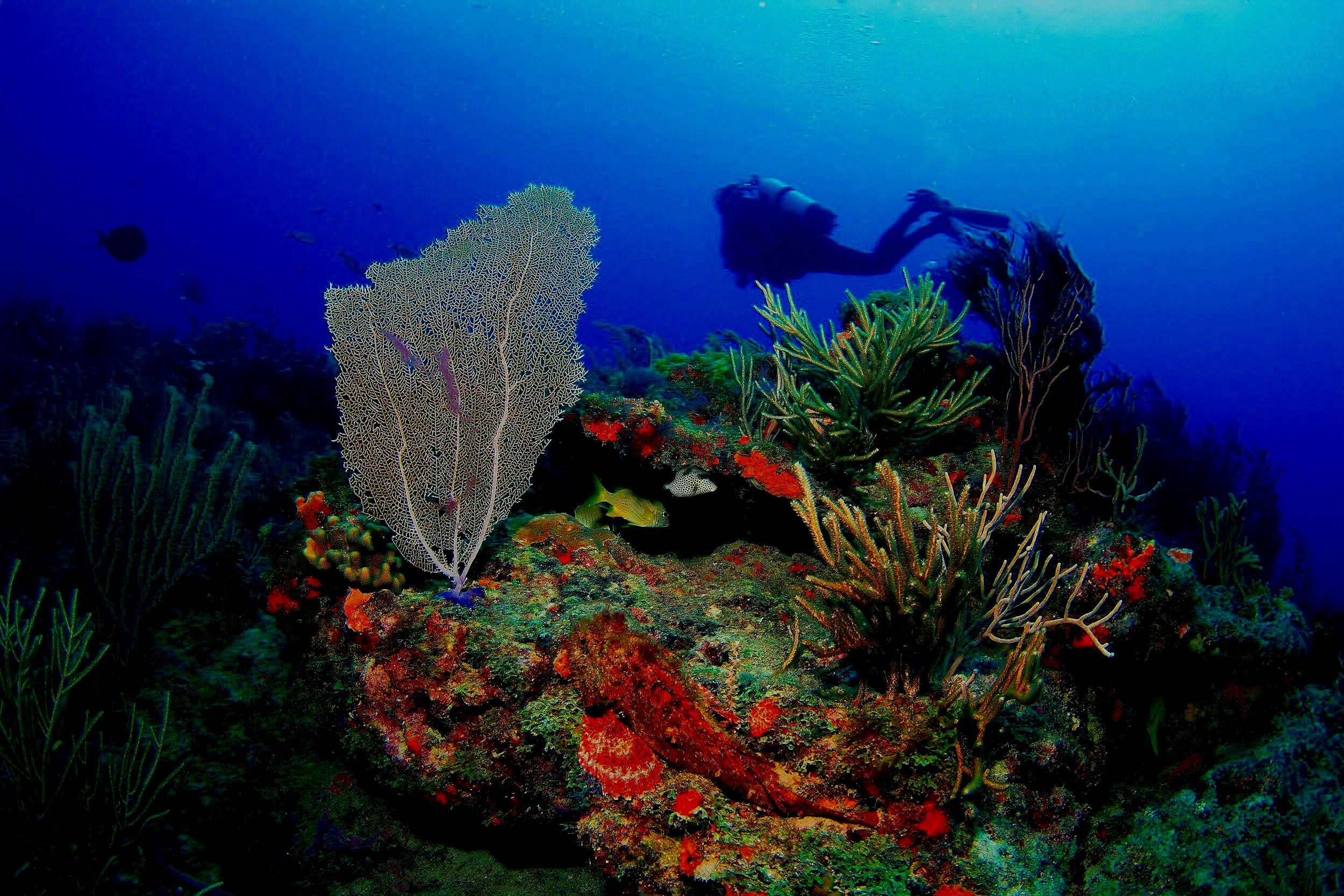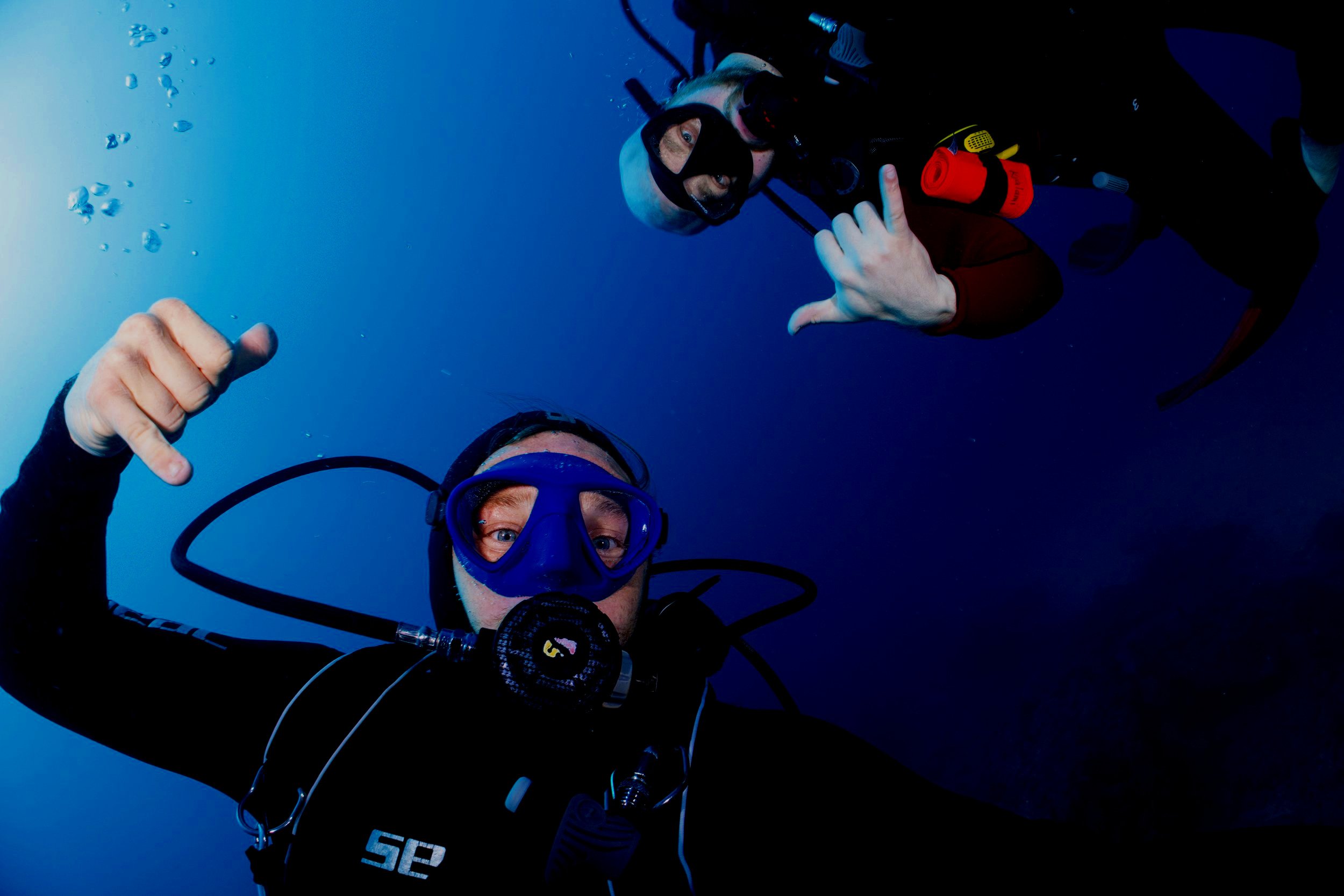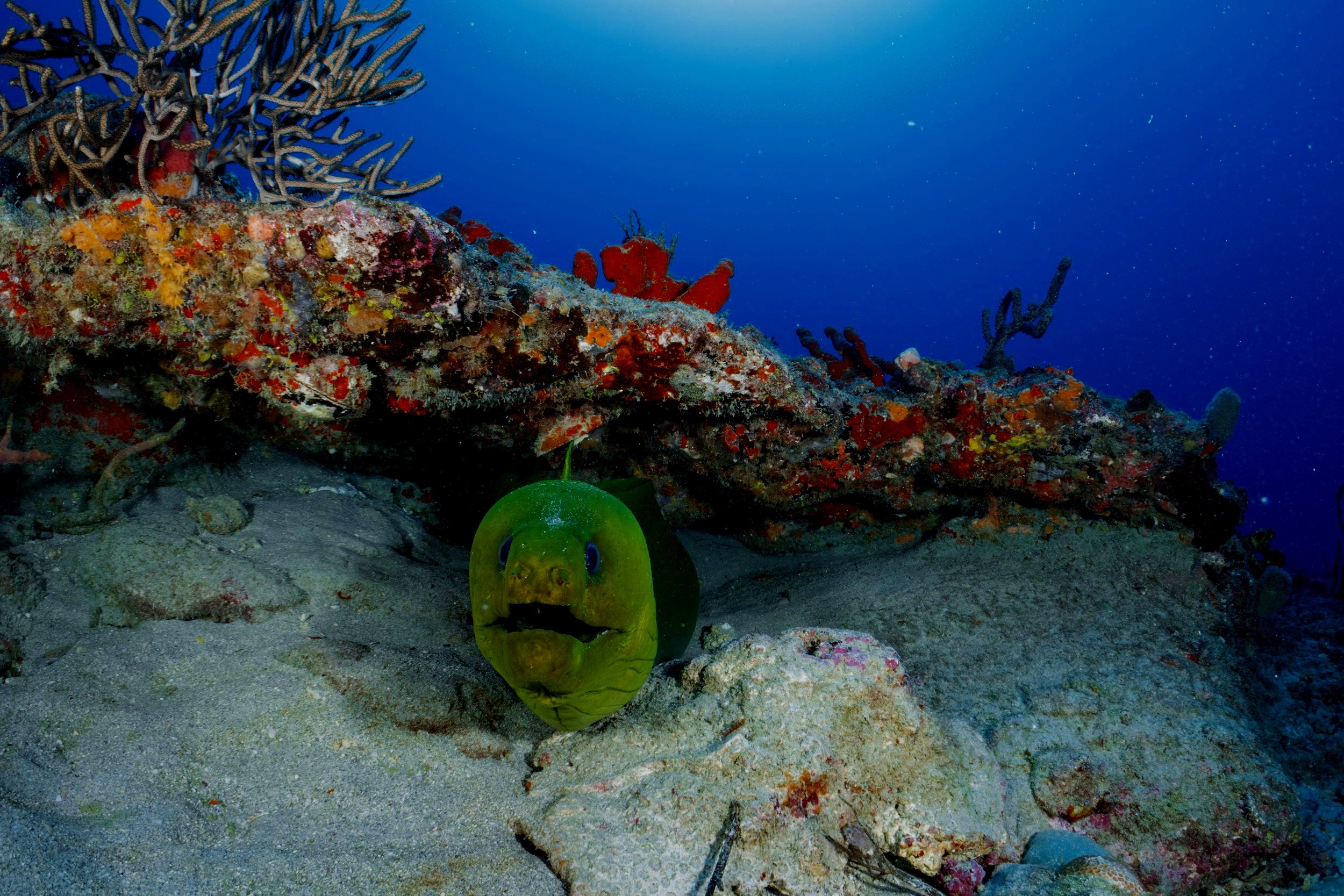A detailed description of …
Palm Beach Scuba Diving
"Florida Diving With A Different Drift"
by Walt Stearns
Often, when a conversation is initiated on the topic of diving in Florida, reference is usually made about the Treasure Coast, and for good reason too. Like the waters to its south (Ft. Lauderdale, Miami's Gold Coast area and Florida Keys), the Treasure Coast is not without the abundance of fascinating subjects. This includes beautiful tropicals, gamefish and pelagics, and huge lobsters. Some of these delectable, spiny crustaceans have been found at weights of 12 to 15 pounds!
Although the abundance of marine life might give some basis to this particular region's nickname, the epithet "Treasure Coast" was actually acquired from the demise of the luckless Spanish Plate Fleet. This armada was destroyed in 1715 by a hurricane while bound for Spain with a capacious cargo of gold and silver. Despite the fact that the bulk of the treasure has never been found, on occasion, the sea has yielded some pieces from the ill-fated fleet to those fortunate divers who were "in the right place at the right time."
At the very heart of Florida's Treasure Coast is the Palm Beaches, a stretch of coastline which spans Riviera Beach, down through West Palm Beach and on to Lake Worth. For decades, the Palm Beaches have been defined as the Southeast retreat for the rich and famous. Simple cruising down this section of the coasts famed A1A highway, past the bright sand beaches and stately mansions, will easily substantiate the sentiment.
A little more than twenty years ago, were vacationers so preoccupied with what was happening on land, almost no one paid attention to what lay offshore. Much less below the surface. In addition, this portion of Treasure Coast was overlooked as a major dive destination because the Florida Keys were receiving most of the publicity. All too often the dive community would hear advertising campaigns encouraging "Dive Pennekamp", but that, is understandable. In comparison, the reef structure of the Treasure Coast is no match to the striking coral formations in the Keys. Instead, they share a similar low profile bottom topography with deep undercuts and ledges like those found off Miami and Fort Lauderdale. However, they do have one unique advantage over all other diving locations along Florida's coastline - the Gulf Stream.
This massive oceanic current swings closer to shore to West Palm Beach than anywhere else along the state. The result is a remarkable catalyst for an environment of warm, clear blue water (70 to 100 foot visibility is the norm) deposited by the currents steady northward flow, and a host of marine creatures, some seldom found anywhere else in Florida. This also gives rise to West Palm Beach's special forte, drift diving. The drill is quite simple. The dive boat (depending on the operation of choice) lines up on one of the two main reef tracts that run just offshore. Divers are then dropped in groups of six to twelve and they are followed by the boat while the current takes them along the reef. To aid proficiency in ascertaining divers' position, the position of the divers, each group is assigned a tethered float that marks their exact location as they drift. While some may view this type of diving as somewhat of an annoyance, the current (often traveling two to four knots) allows divers to experience the thrill and grace of drifting over a large expanse of subsea terrain in a short period of time, with little to no effort! And when you're 60 to 90 feet down sucking air, time is everything. What makes the Palm Beach area even more compelling is the noted populace of sea turtles! We all know how envious we can get whenever someone returns from a dive boasting about swimming with a large sea turtle. Here that type of bragging might only elicit a yawn. To be more succinct, this area alone has perhaps the highest number of resident sea turtles per acre than anywhere in the Southeastern United States. So much so that divers have on occasion reported being outnumbered by these mammoth marine reptiles during the months of April through June (the peak of mating and nesting season). Now that's something to boast about!
At present, four of the world's seven species of sea turtles visit the area- green (Chelonia mydas), hawksbill (Eretmochelys imbricata), loggerhead (Caretta careta), and the colossus of them all, the giant leatherback (Dermochelys coriacea) which can grow to 1,300 pounds. While green and leatherback (rarest of the two) are generally seen only during their nesting periods, hawksbills, and loggerheads are the most frequently seen year-round. It is now considered rare not to see one or more of them either cruising along the bottom or resting under one of the reefs or many ledges found along the shoreside edges.
To increase the odds of observing turtles in their environment it is recommended you venture to the reefs in the 60 to 90 foot range. The reasoning behind this hinges on West Palm's unique geography. In relation to the rest of the Florida East coast in the area around the Palm Beaches features a slight eastward protuberance into the sea. This is coupled with the fact that this region also fronts the narrowest continental shelf in the state, giving some rise to why the Gulf Stream sweeps in so close. Since it is further up the state and farther away from the tropics, West Palm's reef system is initially made up of remnants of ancient coral beds and limestone bedrock. Consisting mainly of two principal tracts, one located in the 50 to 70 foot range with the second in the 70 to 100 foot range, both run as a series of broken stretches in a north south progression along the coast. Some of these locations are recognized by such names as Valley Reef, Koller's Reef, the Bluffs, Mid Reef, the Anchorage, Double Ledges and Breakers. Ornately covered with a host of live corals and brightly colored sponges (most in shades of orange), these deeper reefs feature the type of profound ledge formations sea turtles rest under, safe from predators and wave surge.
In addition to finding sea turtles, the ledges are also home to many of the things divers often like to see: schools of assorted reef fish, small tropicals, lobster and the occasional eagle ray, shark or amberjack. If you're thinking about taking lobster, it is advisable to check with the dive shops for state rules and regulations regarding taking game. At present, the carapace of a spiny lobster must measure three or more inches, or the tail at least 5 1/2 inches in length. The season runs from August 1 to March 31. Failure to comply with game laws can result in stiff fines and/or penalties.
In addition to the reefs, fish and sea turtles, the waters of the West Palm Beach area are not without at least a few wrecks of their own. One of the areas most famous and well known sites is the wreck of the Mizpah. Sunk intentionally as an artificial reef more than fifteen years ago, the history of this 185 foot ship goes back a long way. As the story goes, the Mizpah was a private, steel hulled, luxury yacht, formerly owned by a Greek tycoon before WWII. Following the onset of the war, she was donated for services as a troop carrier in the Atlantic. After successfully evading German U-boats all the way to the close of war, she was later sold and used as a banana freighter. Like many old and tired ships in the Caribbean, she subsequently found her way to the Miami River to be used as scrap. Seeing a need for some better fish attractors for sportfishing in the West Palm Beach area, the Mizpah was purchased for what was to be her last and final mission.
Sitting upright in 90 feet on a sand bottom, she is still remarkably intact. What makes this site so memorable is its tremendous coral and other types of marine growth as well as being home to a large populace of fish, including some of the largest blue angelfish I have ever seen. The Mizpah is one of the most entertaining wrecks to penetrate and explore. Before her sinking, all the doors and portholes were removed for divers' safety, leaving her well-exposed to light for the flushing effect of ever-present currents. Consequently, lights are seldom needed when exploring the wreck.
Not far from the Mizpah, in fact right next to her, is the wreck of PC11, a former military patrol craft that was sunk a few years later. A little further away (approximately 300 yards) on the barren sand bottom is the wreck of the Amaryllis. Approximately 300 feet in length the Amaryllis is a huge freighter with only the hull and lower decks remaining. But, like many of the wreck sites here it is not without copious fish. In addition, the interior of all three of these wrecks abound with an impressive collection of spiny oysters.
Just a short distance north of the Palm Beach Inlet is the Barge Wreck. While barges used for artificial reef sites may not quicken the pulse, what sometimes collects around them just might. From what I have heard, Barge Wreck is home to a couple of large green morays and the occasional 200 to 300 pound jewfish. Unlike the wreck sites further north , the barge lays atop a natural reef at a depth of 65 to 75 feet. Many dive operators plan drifts over the reef and the barge so divers can experience both at the same time.
South of the inlet is another set of 3 wrecks in an area designated simply as Artificial Reef Site Number 2. The Owens, or more popularly called by its true name, the Eidsvag, is a 125 foot freighter sunk back in December, 1985 in 85 feet of water. The reef includes the Barge, a small barge placed on the bottom the same year as the freighter, and the Rolls Royce, a former mint condition F1O//S Royce Silver Cloud were donated by two individuals to kick off the initiation of the county's Artificial Reef Committee. Where else but West Palm Beach would anyone sink a perfectly good, very expensive automobile? Looking at the car's deteriorating body, I don't think even AAA could help it now.
Not surprising is that the West Palm area is host to a multitude of diving facilities ready to offer local and vacationing divers just about anything they could ask for. I do most of my Palm Beach diving with The Scuba Club, Inc. Billed as the "Country Club for Divers", they are a full-scale facility with a well stocked and staffed Pro Shop and most of latest lines of diving equipment and rental gear. They also have their own classroom with training pool, bathrooms with hot showers, swimming pool and a steam room, as well as their own boat dock on the premises. What makes the diving here even more enjoyable is an overnight stay in their upstairs, fully furnished apartment, large enough for four, and the fee starts at $100 per night. Most significant is that while most of their attention is focused on safety first, the "Club" is able to provide trips that are not only convenient, but also equally exciting and diverse. Going out each day, all trips are conducted as a series of one tank, escorted dives (with at least two divemasters) on the outer reefs and/or wrecks. Once the dive is completed, they make a quick return trip (approximately 15 to 20 minutes) to their dock so that the divers can cool off in the pool while degassing for their next dive. It beats sitting in the boat under the hot sun for an hour.
Despite their continual growth in popularity, Palm Beach dive sites are never as crowded as those in the upper Florida Keys. With visibility normally 60 feet or better, (although 90 to 100 feet is not uncommon) there is always an abundance of marine life for the photographer or sightseer. In knowing this, I find the lack of attendance somewhat strange. My best reasoning is that quite likely, most local divers (in the state of Florida) as well as those out-of-state, are still not aware of West Palm's undersea find. And if that should be the case, do you think I should tell them?
Reprinted from Discover Diving magazine with the permission of Watersport Publishing Inc., P.O. Box 83727, San Diego, CA 92138 USA



